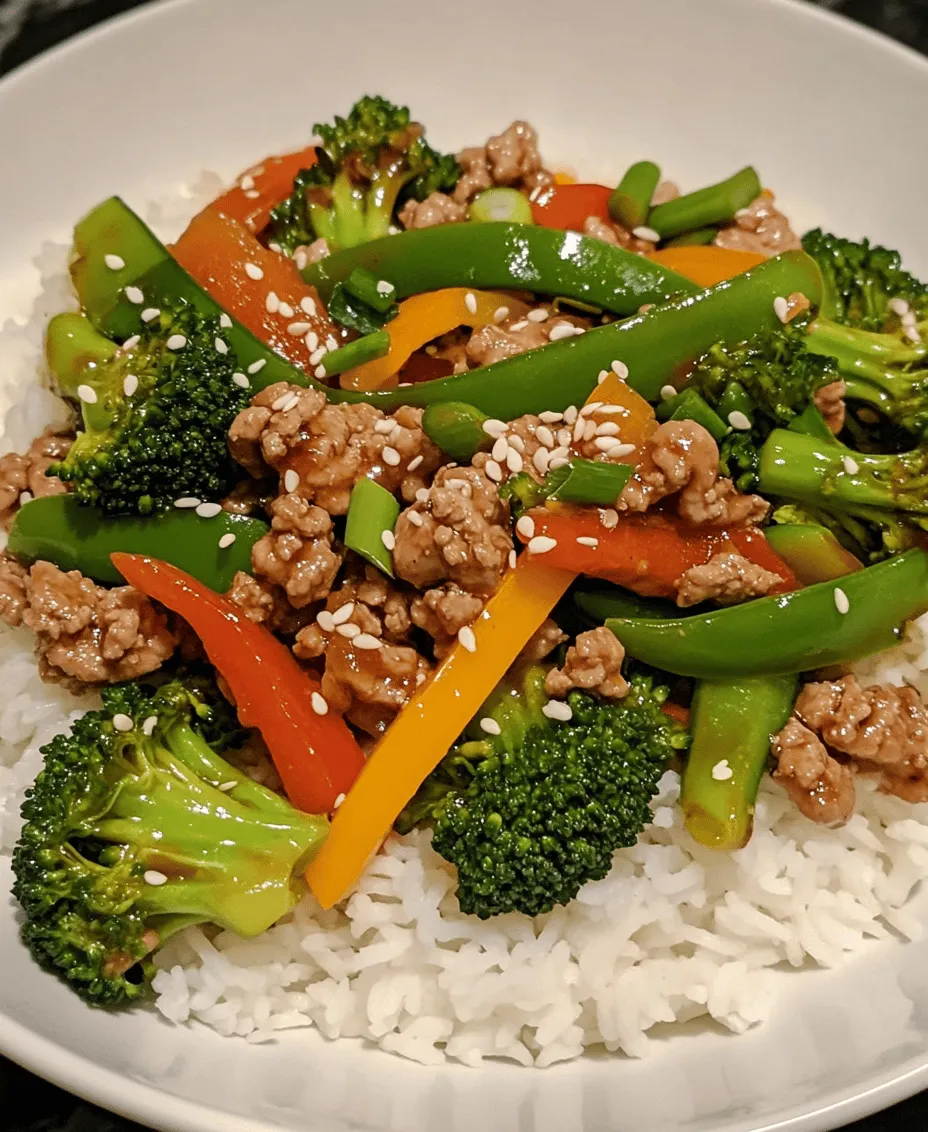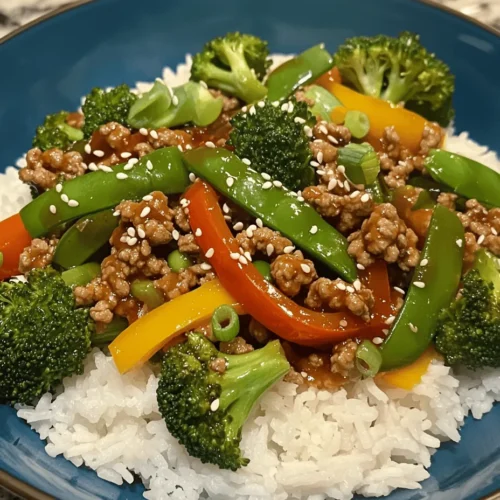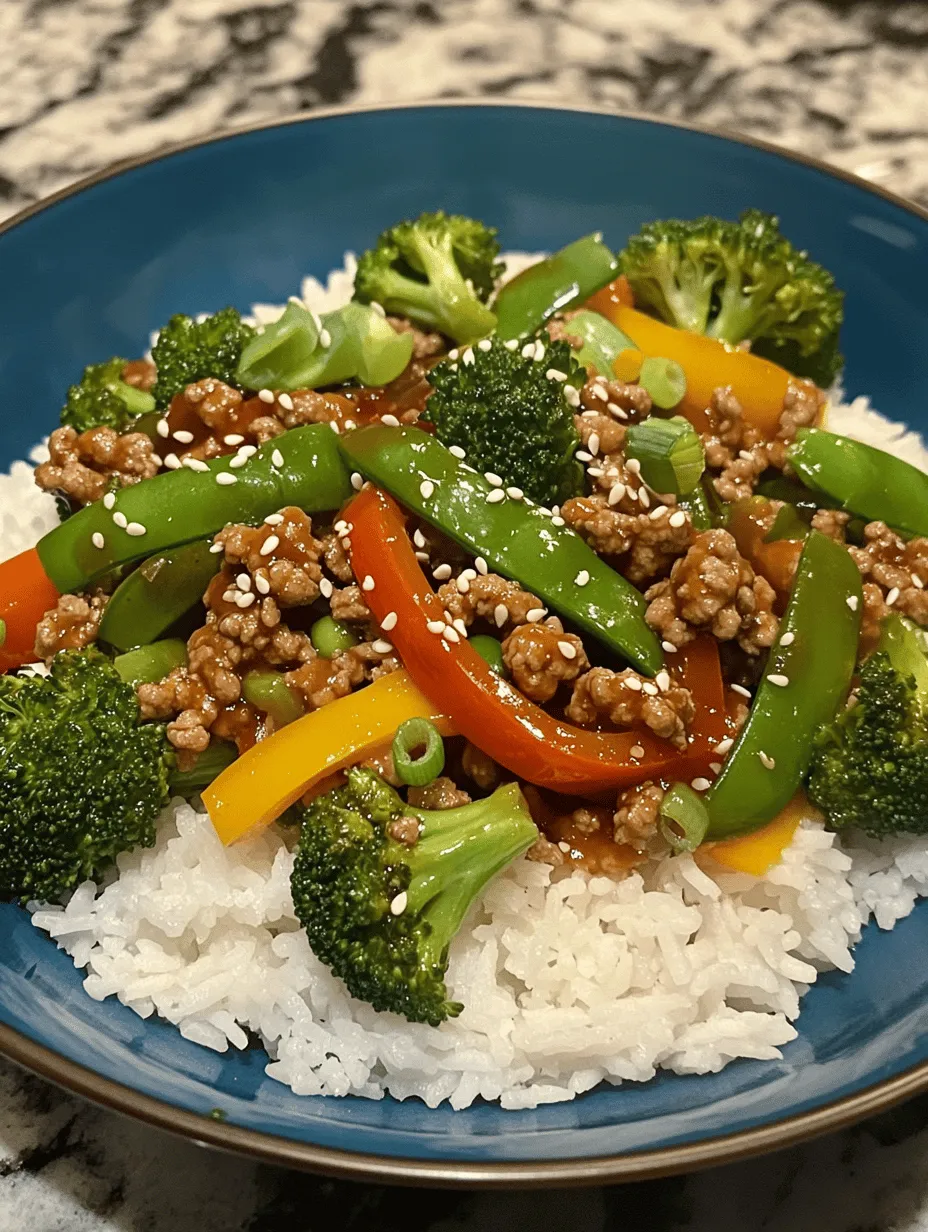Introduction
Stir fry dishes have gained immense popularity across various cuisines worldwide, particularly in Asian culinary traditions. This cooking method, characterized by its quick preparation and vibrant flavors, allows for the incorporation of fresh ingredients and a variety of proteins. One standout recipe that exemplifies the balance of taste and nutrition is the Sweet & Savory Ground Turkey Teriyaki Stir Fry. This dish not only showcases the delicious harmony between sweetness and savoriness but also offers a healthier alternative to traditional stir fry recipes, making it a favorite among health-conscious foodies.
The allure of this ground turkey teriyaki stir fry lies in its ability to deliver a burst of flavor while keeping the dish light and nutritious. Ground turkey serves as an excellent protein source, and when paired with an array of colorful vegetables, it transforms into a wholesome meal that everyone can enjoy. The importance of balancing sweet and savory flavors in Asian-inspired dishes cannot be overstated, as this combination creates a satisfying experience that keeps you coming back for more.
Understanding the Ingredients
Ground Turkey: A Healthy Protein Source
Ground turkey has emerged as a popular choice for those seeking a leaner alternative to beef or pork. With its lower fat content, ground turkey is not only a protein powerhouse but also a versatile ingredient that can adapt to various flavors and cuisines. Rich in essential nutrients such as B vitamins, phosphorus, and selenium, ground turkey supports muscle growth, boosts metabolism, and promotes overall health.
In this Sweet & Savory Ground Turkey Teriyaki Stir Fry, ground turkey takes center stage, providing a hearty base for the dish. Its mild flavor pairs exceptionally well with the vibrant teriyaki sauce and the assortment of vegetables, creating a satisfying meal that doesn’t compromise on taste.
Nutritional Benefits of the Vegetables
In addition to ground turkey, this stir fry features a colorful medley of vegetables, including broccoli, bell peppers, snap peas, and green onions. Each of these vegetables contributes unique flavors and nutritional benefits to the dish:
– Broccoli: This cruciferous vegetable is a nutritional powerhouse, packed with vitamins C and K, fiber, and antioxidants. Broccoli not only adds a delightful crunch to the stir fry but also aids in digestion and supports immune health.
– Bell Peppers: Rich in vitamins A and C, bell peppers bring a sweet, juicy element to the recipe. They are also a good source of fiber and antioxidants, making them a nutritious addition to any meal.
– Snap Peas: These tender, crisp peas add a refreshing sweetness to the stir fry. They are low in calories and high in fiber, making them a great choice for those looking to maintain a healthy diet.
– Green Onions: Also known as scallions, green onions provide a mild onion flavor that enhances the overall taste of the stir fry. They are low in calories and rich in vitamins A, C, and K.
Combining these vegetables not only boosts the nutritional content of the dish but also adds vibrant colors and textures that make the stir fry visually appealing.
Teriyaki Sauce Components
The teriyaki sauce is a crucial element that ties all the flavors together in this recipe. Traditionally, teriyaki sauce consists of a few simple yet impactful ingredients, including:
– Soy Sauce: This fermented condiment adds a salty umami flavor to the sauce. For a healthier option, consider using low-sodium soy sauce, which significantly reduces the sodium content without sacrificing flavor.
– Honey or Maple Syrup: Both sweeteners provide the necessary sweetness to balance the saltiness of the soy sauce. Honey lends a rich, floral note, while maple syrup offers a distinct caramel flavor.
– Rice Vinegar: This mild vinegar adds a touch of acidity that brightens the flavor profile of the sauce. It helps to cut through the richness of the other ingredients and enhances the overall taste.
– Sesame Oil: With its nutty aroma and flavor, sesame oil adds depth to the sauce. It also brings a hint of richness that complements the other ingredients beautifully.
Importance of Fresh Garlic and Ginger
To elevate the flavor profile of the teriyaki sauce, fresh garlic and ginger are essential. Garlic adds a pungent, savory note that enhances the overall taste of the dish, while ginger provides a warm, spicy kick. Both ingredients are known for their health benefits, including anti-inflammatory properties and digestive support. Using fresh garlic and ginger instead of powdered versions ensures a more vibrant flavor, making the teriyaki sauce truly shine.
Preparation of the Sauce
Step-by-Step Process to Create Homemade Teriyaki Sauce
Creating your own teriyaki sauce at home is a straightforward process that allows you to customize the flavors to your liking. Here’s how to make a delicious homemade teriyaki sauce:
1. Gather Ingredients: To make the sauce, you will need:
– 1/2 cup low-sodium soy sauce
– 1/4 cup honey or maple syrup
– 2 tablespoons rice vinegar
– 1 tablespoon sesame oil
– 2 cloves garlic, minced
– 1 teaspoon fresh ginger, grated
– 1 tablespoon cornstarch
– 2 tablespoons water (for cornstarch slurry)
2. Mix the Sauce Ingredients: In a medium bowl, combine the soy sauce, honey or maple syrup, rice vinegar, sesame oil, minced garlic, and grated ginger. Whisk the mixture until well combined.
3. Prepare the Cornstarch Slurry: In a separate small bowl, mix the cornstarch with 2 tablespoons of water to create a slurry. This will help thicken your teriyaki sauce.
4. Combine and Heat: Pour the sauce mixture into a small saucepan and bring it to a gentle simmer over medium heat. Once it starts to bubble, add the cornstarch slurry while stirring continuously. Cook for an additional 1-2 minutes until the sauce thickens to your desired consistency.
5. Taste and Adjust: Taste the sauce and adjust the flavors if necessary. Add more sweetness with additional honey or maple syrup, or a splash more vinegar for acidity.
Benefits of Using Low-Sodium Soy Sauce
Using low-sodium soy sauce in your teriyaki sauce is a simple way to create a healthier version of this classic condiment. Regular soy sauce can be quite high in sodium, which may contribute to health issues like high blood pressure. By opting for low-sodium soy sauce, you can enjoy the rich umami flavor without the excessive salt content, making your dish more heart-healthy.
Role of Honey or Maple Syrup
Honey or maple syrup not only adds sweetness but also enhances the overall flavor complexity of the teriyaki sauce. Honey has a thick consistency that helps create a luscious sauce, while maple syrup provides a unique flavor that can complement the other ingredients beautifully. Both sweeteners also offer natural benefits, such as antioxidants and vitamins, making them preferable to refined sugars.
Explanation of Cornstarch Slurry
The cornstarch slurry is a key component in achieving the perfect teriyaki sauce consistency. When combined with liquid and heated, cornstarch thickens the sauce, giving it a glossy, rich texture that clings beautifully to the ground turkey and vegetables. This ensures that every bite is packed with flavor, enhancing the overall dining experience.
Cooking the Ground Turkey
Best Practices for Cooking Ground Turkey
Cooking ground turkey is relatively simple, but following a few best practices can ensure that it is both safe and flavorful. Here’s how to properly cook ground turkey:
1. Choose the Right Pan: A large skillet or wok is recommended for stir-frying ground turkey. The wide surface area allows for even cooking and browning.
2. Heat the Pan: Preheat your skillet over medium-high heat. This helps to sear the turkey quickly, sealing in the juices and enhancing the flavor.
3. Add Oil: Use a small amount of cooking oil, such as vegetable or canola oil, to coat the pan. This prevents the turkey from sticking and helps achieve a nice brown color.
4. Cook Thoroughly: Add the ground turkey to the hot pan and break it apart using a spatula. Cook for about 5-7 minutes, stirring frequently, until the turkey is browned and cooked through. The internal temperature should reach 165°F (74°C) for safe consumption.
Tips for Breaking Apart Turkey Efficiently
To ensure that the ground turkey cooks evenly and thoroughly, it’s essential to break it apart as it cooks. Use a wooden spoon or spatula to crumble the turkey into smaller pieces. This not only helps with even cooking but also allows for better flavor absorption from the teriyaki sauce and vegetables.
Importance of Browning for Flavor Development
Browning ground turkey is crucial for flavor development. The Maillard reaction, which occurs when proteins and sugars undergo chemical changes during cooking, creates rich, complex flavors and a pleasing aroma. To achieve a good browning effect, avoid overcrowding the pan, as this can cause steaming instead of searing. If needed, cook the turkey in batches to ensure optimal browning.
Sautéing the Vegetables
Techniques for Achieving the Perfect Tender-Crisp Texture
Sautéing vegetables in a stir fry is an art that requires attention to detail to achieve the perfect tender-crisp texture. Here are some techniques to consider:
1. Prep the Vegetables: Cut the vegetables into uniform sizes to ensure even cooking. For this recipe, chop broccoli into small florets, slice bell peppers into thin strips, and trim the ends of the snap peas.
2. Heat the Pan: After cooking the ground turkey, remove it from the pan and set it aside. Add a little more oil if necessary and heat the pan to medium-high again.
3. Add Vegetables in Stages: Begin by adding the vegetables that take longer to cook, such as broccoli. Sauté for about 2-3 minutes until they begin to soften. Then, add the bell peppers and snap peas, cooking for an additional 2-3 minutes. The goal is to cook the vegetables until they are vibrant in color and still retain a slight crunch.
4. Avoid Overcooking: Keep a close eye on the vegetables, as overcooking can lead to mushy textures. Stir-frying should be quick, allowing the vegetables to cook through while still preserving their crispness.
5. Seasoning: A sprinkle of salt and pepper during the sautéing process can enhance the natural flavors of the vegetables, making them even more delicious.
By mastering these techniques, you can create a Sweet & Savory Ground Turkey Teriyaki Stir Fry that is not only visually appealing but also bursting with flavor and nutrition. In the next part of this article, we will dive into assembling the stir fry and bringing all the elements together for a delightful culinary experience.

Timing is Everything: Maximizing Flavor with Garlic and Ginger
When creating a Sweet & Savory Ground Turkey Teriyaki Stir Fry, timing is crucial, especially when adding garlic and ginger. These ingredients contribute significantly to the dish’s overall flavor profile, but they must be handled correctly to maximize their potential.
Garlic should be added after the turkey has cooked through and is starting to brown. This timing allows the garlic to infuse the meat with its aromatic flavor without burning. If added too early, garlic can turn bitter, negatively impacting the dish’s taste.
Ginger, on the other hand, should be introduced just moments before the sauce is added. This ensures that its fresh, zesty flavor remains vibrant and doesn’t lose its potency through prolonged cooking. By timing the addition of these ingredients thoughtfully, you enhance the stir fry’s flavor complexity and create a more enjoyable meal.
Choosing and Preparing Vegetables for Stir Fry
Selecting the right vegetables is essential for a stir fry, as they not only add color and texture but also bring essential nutrients to the dish. Here are some tips for choosing and preparing vegetables:
1. Freshness is Key: Opt for seasonal vegetables whenever possible. Fresh produce not only tastes better but retains more nutrients. Look for vibrant colors and firm textures when selecting your veggies.
2. Cut Uniformly: Chop vegetables into similar-sized pieces to ensure even cooking. Smaller pieces cook faster, while larger chunks take longer. For a balanced stir fry, consider the cooking times of each vegetable.
3. Variety of Textures: Combine crunchy vegetables like bell peppers, snap peas, and carrots with softer ones like zucchini or mushrooms. This contrast adds depth to the dish and keeps each bite interesting.
4. Prepping Techniques: Wash and dry your vegetables thoroughly before cutting them. If you’re using leafy greens like bok choy or spinach, ensure they are properly dried to avoid excess moisture which can lead to steaming instead of stir-frying.
Combining Ingredients for the Stir Fry
Now that you have your turkey, garlic, ginger, and vegetables ready, it’s time to bring them all together. Here are the steps to ensure a delightful stir fry:
1. Heat Management: Start by heating your pan or wok over medium-high heat. Once hot, add a tablespoon of oil (like sesame or vegetable oil) to coat the bottom. Proper heat management is critical; too low, and your ingredients may steam rather than stir-fry.
2. Cooking the Turkey: Add the ground turkey first, breaking it up with a spatula. Cook until it’s browned and fully cooked through, about 5-7 minutes.
3. Incorporating Aromatics: Once the turkey is cooked, add the minced garlic and ginger. Stir continuously for about 30 seconds until fragrant, being careful not to let them burn.
4. Vegetable Addition: Next, add your prepared vegetables. Start with the denser ones, like carrots and bell peppers, since they take longer to cook. Stir-fry for about 3-4 minutes before adding softer vegetables like snap peas and zucchini.
5. Saucing It Up: After your vegetables are tender yet crisp, pour in your teriyaki sauce. Ensure even distribution by stirring continuously, coating all ingredients. Allow the mixture to bubble for a minute or two to let the flavors meld.
6. Adjust Cooking Times: Keep an eye on the texture of your vegetables. If you prefer them crunchier, reduce cooking time. Overcooking can lead to a mushy stir fry, so aim for a vibrant, crisp finish.
Finishing Touches
The finishing touches can elevate your stir fry from delicious to extraordinary. Here’s how to add those final elements:
– Green Onions: Chop green onions and sprinkle them over the top of your dish just before serving. They add a fresh flavor and a pop of color that enhances the presentation.
– Sesame Seeds: Toasted sesame seeds are an excellent garnish for both flavor and visual appeal. Sprinkle a generous amount over the stir fry for a nutty crunch that complements the savory notes of the teriyaki sauce.
Serving Suggestions
To round out your Sweet & Savory Ground Turkey Teriyaki Stir Fry, consider these serving suggestions:
1. Rice Options: The base of your stir fry can significantly alter the meal’s profile. Jasmine rice is fragrant and pairs well with the teriyaki flavors, while brown rice offers a nuttier taste and added fiber. Choose according to your dietary preferences.
2. Plating Tips: When plating, use a large spoon to serve the stir fry over the rice, creating a mountain effect. Garnish with the green onions and sesame seeds to make the dish visually appealing.
3. Pairing Ideas: Consider serving the stir fry alongside a light side salad or steamed vegetables to complement the rich flavors. A simple cucumber salad dressed in rice vinegar can provide a refreshing contrast.
Nutritional Information
Understanding the nutritional benefits of your dish is essential for making informed choices. Here is a breakdown of the nutritional content per serving of Sweet & Savory Ground Turkey Teriyaki Stir Fry:
– Calories: Approximately 350-400 calories per serving, depending on the amount of sauce and rice.
– Protein: Ground turkey is a lean protein source, providing about 30 grams of protein per serving, making it an excellent choice for muscle maintenance and growth.
– Fats: The dish contains healthy fats primarily from the sesame oil and any seeds used, totaling around 10-15 grams.
– Carbohydrates: With rice included, expect around 50 grams of carbohydrates, offering a good source of energy.
Health Benefits: Each ingredient in this stir fry contributes to health in various ways. For example, bell peppers are rich in vitamin C, while ginger helps with digestion. Ground turkey provides lean protein, and the vegetables add necessary fiber and antioxidants.
Dietary Considerations: This recipe can be modified to suit various dietary restrictions. For a gluten-free version, use tamari instead of traditional soy sauce, and for low-carb options, serve it over cauliflower rice instead of regular rice.
Conclusion
The Sweet & Savory Ground Turkey Teriyaki Stir Fry is not only a simple and quick dish to prepare but also packed with health benefits and flavor. From the timing of your ingredients to the choice of vegetables, every step is designed to create a delicious meal that is both nutritious and satisfying.
Feel free to experiment with the recipe by adding different vegetables or proteins to suit your taste. This dish is incredibly versatile, making it a fantastic option for weeknight dinners or meal prep for the week ahead. So, gather your ingredients, fire up your stove, and enjoy a delightful stir fry that brings the tastes of Asia right to your kitchen.



